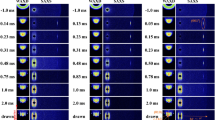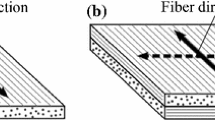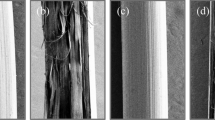Abstract
The thermal behavior of single filament of pitch fibers has been investigated using thermomechanical analysis (TMA). Thermal characteristic parameters such as glass transition temperature (T g) and linear coefficients of thermal expansion (CLTE) below and above T g were determined with high reproducibility to probe the conditions of pitch fiber materials. Different loads and heating rates were applied to examine their effects on measurement results. A load-free CLTE below T g can be extracted from the intercept of CLTE–stress curve, showing a constant value of 63.3 μm/(m °C) for the pitch fibers spun from different spinning speeds. On the other hand, the free CLTE above T g showed a remarkable trend decreased from positive to negative for pitch fibers produced with accelerated spinning speed. The isotropic pitch fibers can be partially oriented to fiber axis under strong elongation, and the limited degree of orientation is confirmed by X-ray diffraction. Thus, the free CLTE above T g can serve as an excellent indication of degree of preferred orientation for pitch fibers.







Similar content being viewed by others
References
Fu X, Lu W, Chung DDL (1998) Ozone treatment of carbon fiber for reinforcing cement. Carbon 36:1337–1345. doi:10.1016/S0008-6223(98)00115-8
Egashira M, Takatsuji H, Okada S, Yamaki J (2002) Properties of containing Sn nanoparticles activated carbon fiber for a negative electrode in lithium batteries. J Power Sources 107:56–60. doi:10.1016/S0378-7753(01)00980-6
Jin H, Park S-E, Lee JM, Ryu SK (1996) The shape-selectivity of activated carbon fibers as a palladium catalyst support. Carbon 34:429–431. doi:10.1016/0008-6223(96)87613-5
Lozano-Castelló D, Alcañiz-Monge J, de la Casa-Lillo MA et al (2002) Advances in the study of methane storage in porous carbonaceous materials. Fuel 81:1777–1803. doi:10.1016/S0016-2361(02)00124-2
Navarri P, Marchal D, Ginestet A (2001) Activated carbon fibre materials for VOC removal. Filtr Sep 38:33–40. doi:10.1016/S0015-1882(01)80150-6
Khandare PM, Zondlo JW, Pavlovic AS (1996) The measurement of the glass transition temperature of mesophase pitches using a thermomechanical device. Carbon 34:663–669. doi:10.1016/0008-6223(95)00202-2
Berrueco C, Álvarez P, Díez N et al (2012) Characterisation and feasibility as carbon fibre precursors of isotropic pitches derived from anthracene oil. Fuel 101:9–15. doi:10.1016/j.fuel.2011.10.005
Yoon S-H, Korai Y, Mochida I (1994) Assessment and optimization of the stabilization process of mesophase pitch fibers by thermal analyses. Carbon 32:281–287
Prauchner MJ, Pasa VMD, Otani C, Otani S (2004) The use of DSC to assess the stabilization of thermoplastic eucalyptus tar pitch fibers. J Therm Anal Calorim 76:935–940. doi:10.1023/B:JTAN.0000032278.06131.69
Ogale AA, Lin C, Anderson DP, Kearns KM (2002) Orientation and dimensional changes in mesophase pitch-based carbon fibers. Carbon 40:1309–1319. doi:10.1016/S0008-6223(01)00300-1
Hamada T, Furuyama M, Tomioka T, Endo M (1992) Preferred orientation of pitch precursor fibers and carbon fibers prepared from isotropic pitch. J Mater Res 7:1178–1188. doi:10.1557/JMR.1992.1178
Senbiao H, Zhongmin G, Xiaoye M et al (2012) Properties, morphology and structure of BPDA/PPD/TFMB polyimide fibers. Chem Res Chin Univ, p 752–756
Riesen R, Schawe JEK (2000) Expansion and shrinkage of fibers: load- and temperature modulated TMA measurements temperature calibration of fiber attachments. J Therm Anal Calorim 59:337–350. doi:10.1023/A:1010116803480
Yang L, Thomason JL (2013) The thermal behaviour of glass fibre investigated by thermomechanical analysis. J Mater Sci 48:5768–5775. doi:10.1007/s10853-013-7369-7
Yang H, Yoon S-H, Korai Y et al (2003) Improving graphitization degree of mesophase pitch-derived carbon fiber by solid-phase annealing of spun fiber. Carbon 41:397–403. doi:10.1016/S0008-6223(02)00320-2
Stephen C (2002) Handbook of thermal analysis and calorimetry, 1st edn. Elsevier
Boyer RF (1970) Thermal analysis. In: Wiedermann HG (ed) 3rd ICTA. Birkhauser Verlag. Basel and Stuttgart
Dyre JC (2006) Colloquium: the glass transition and elastic models of glass-forming liquids. Rev Mod Phys 78:953–972. doi:10.1103/RevModPhys.78.953
Barnes AB, Dauché FM, Gallego NC et al (1998) As-spun orientation as an indication of graphitized properties of mesophase-based carbon fiber. Carbon 36:855–860. doi:10.1016/S0008-6223(97)00166-8
Chand S (2000) Review carbon fibers for composites. J Mater Sci 35:1303–1313. doi:10.1023/A:1004780301489
Gallego NC, Edie DD (2001) Structure–property relationships for high thermal conductivity carbon fibers. Composites Part A 32:1031–1038. doi:10.1016/S1359-835X(00)00175-5
Hamada T, Furuyama M, Sajiki Y et al (1990) Preferred orientation of pitch precursor fibers. J Mater Res 5:1271–1280. doi:10.1557/JMR.1990.1271
Lu S, Blanco C, Rand B (2002) Large diameter carbon fibres from mesophase pitch. Carbon 40:2109–2116. doi:10.1016/S0008-6223(02)00060-X
Acknowledgements
This work was supported by the National Natural Science Foundation of China (No. 51402102).
Author information
Authors and Affiliations
Corresponding author
Electronic supplementary material
Below is the link to the electronic supplementary material.
Rights and permissions
About this article
Cite this article
Luo, F., Ouyang, T. & Fei, Y. Thermal properties of isotropic pitch fibers characterized by thermomechanical analysis. J Mater Sci 51, 3408–3414 (2016). https://doi.org/10.1007/s10853-015-9657-x
Received:
Accepted:
Published:
Issue Date:
DOI: https://doi.org/10.1007/s10853-015-9657-x




